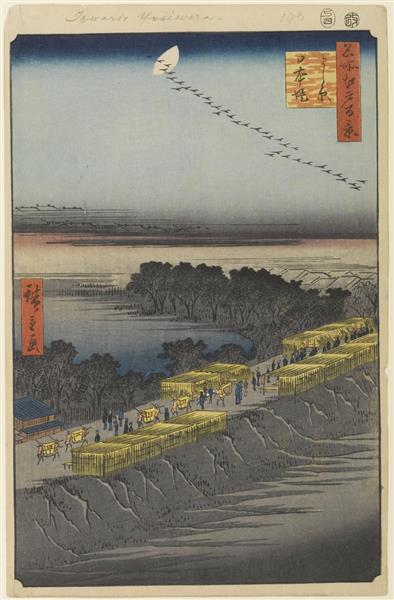Beskrivelse
Utagawa Hiroshige's "Nihon Embankment and Yoshiwara," created in 1857, is one of the most captivating prints of the Edo period, reflecting the artist's mastery in capturing the essence of the Japanese landscape as well as the daily life of his time. Part of the "One Hundred Famous Views of Edo" series, this painting stands as a testament to Hiroshige's ability to amalgamate nature and urban culture into a dynamic visual representation.
At the top of the composition, the sky unfolds in a harmonious transition of hues ranging from a deep blue to softer shades that hint at a sunset, generating a calm and contemplative atmosphere. The quality of the color in this work is a notable aspect; Hiroshige employed a subtle gradation technique that brings the colors to life, making them vibrant and luminous. The brushstrokes are fluid, conveying a sense of movement and fluidity that accompanies the natural environment of the elements depicted.
The embankment, which forms the central element of the work, is bordered by a carefully delineated natural environment. The vegetation is depicted in detail that reflects Hiroshige’s love of nature. Delicate branches and leaves unfurl around, highlighting the interrelationship between the city’s architecture and the surrounding flora. To the left, people are seen walking, suggesting a sense of life and movement. These figures, although small within the composition, are representative of the everyday bustle of the period, evoking the essence of a moment in time. Hiroshige, known for his attention to detail, painted these figures in a simplified yet expressive style that blends seamlessly with the surroundings.
The depiction of Yoshiwara, Edo’s famous pleasure district, adds a layer of cultural complexity to the work. It alludes to the rich social and cultural life that flourished in this area, where pleasure houses and entertainment were an integral part of the urban experience. Hiroshige, by including this aspect, not only documents a geographical location, but also a social phenomenon that was significant in Japanese society. The inclusion of Yoshiwara in the work offers historical context, providing a glimpse into the practices and customs of the time.
In terms of style, Hiroshige is an exponent of ukiyo-e, a form of woodblock printmaking that flourished in Japan during the Edo period. His focus on the transient beauty of everyday life and natural landscapes made his work resonate deeply with his audience. Compared to contemporaries, his style is characterized by a particular sensitivity to changes in light and weather, elements that are evident in “Nihon Embankment and Yoshiwara.” This work stands alongside other notable examples from his career, such as “A Walk Through Nihonbashi Gate” and “One Hundred Famous Views of Edo,” where the treatment of space and color demonstrate the same technical mastery and deep appreciation for the visual narrative of cityscapes.
Hiroshige, through “Nihon Embankment and Yoshiwara,” invites the viewer to immerse themselves in a specific and vital moment in 19th-century Japanese life. By balancing human detail with the magnificence of the natural landscape, Hiroshige not only captures the vision of an era, but also establishes a bridge between aesthetic contemplation and lived experience, a legacy that continues to resonate with contemporary audiences in their search for connection and meaning in art.
KUADROS ©, a famous painting on your wall.
Hand-made oil painting reproductions, with the quality of professional artists and the distinctive seal of KUADROS ©.
Painting reproduction service with satisfaction guarantee. If you are not completely satisfied with the replica of your painting, we will refund 100% of your money.

